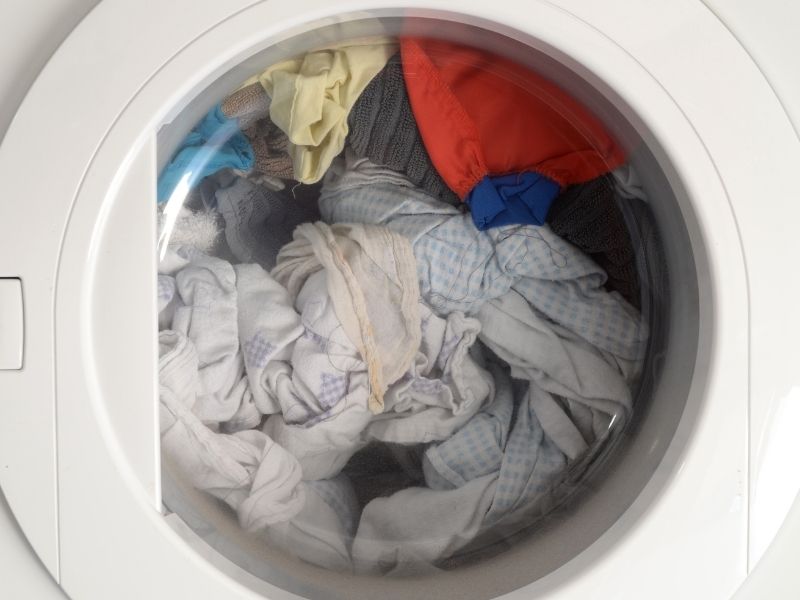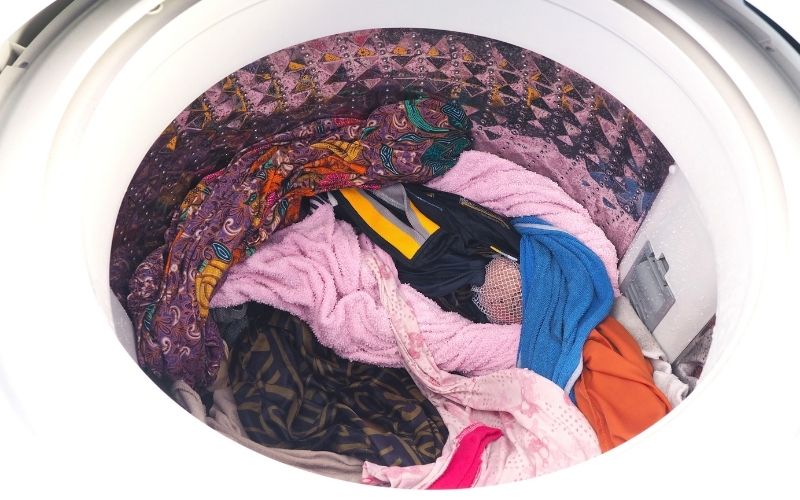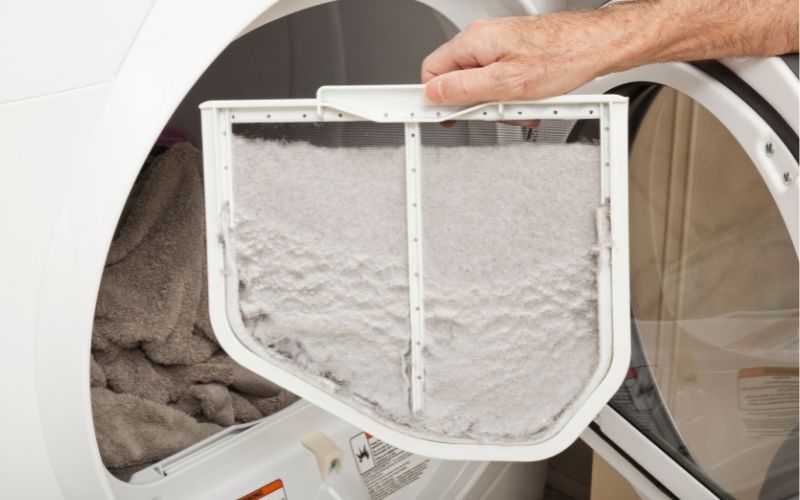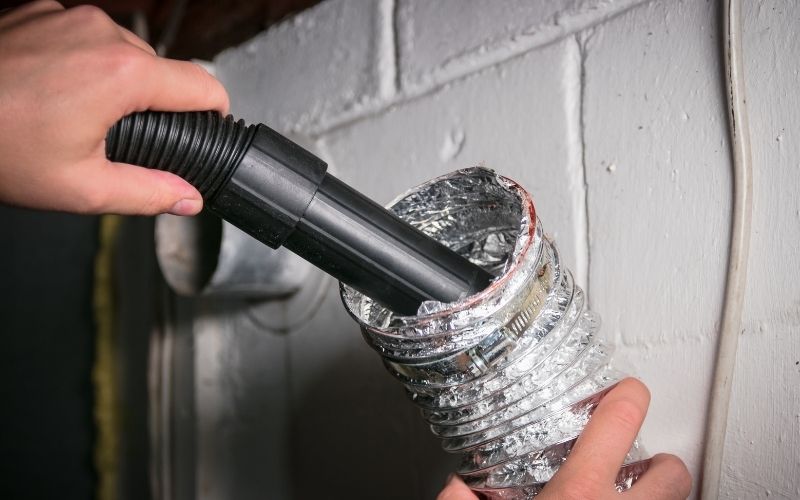Getting everything done on laundry day can be really frustrating if your dryer is taking forever to dry each load. It can be worrying too – is it a sign that your dryer is having problems?
Plus, dryers are energy-hungry appliances – if they’re taking a long time, how much are they costing you to run?
Often, when a dryer is taking a long time it’s not a terminal issue. There are a number of things you can check that can help bring the drying time – and your energy bills – back under control.

How Long Does A Dryer Take?
On average it will take around 40 minutes to dry a load of clothes in a standard dryer. If you have a heavy load then it can take up to 90 minutes, while small loads can be done in just 20 minutes.
There are a lot of different factors in play when working out how long a dryer will take but the biggest is the fabric type. T-shirts and other thin items are a lot faster to dry than denim jeans or thick towels. Those fabrics aren’t just thicker, but they also retain moisture, so the dryer has to work harder to fully dry them out.
Then, there are other factors like the size of the load and the size of the drum. Dryers rely on hot air flowing through the laundry to dry it, so the more free space there is in a drum, the faster it will be able to dry the clothes.
Finally, the type of dryer will also have an impact. Standard dryers are a lot faster than new heat pump models, but also more inefficient.
Vented Vs Condenser Vs Heat Pump
There are three main types of tumble dryer – vented, condenser, and heat pump.
Vented dryers are the most popular in the US, but in Europe, most homes have a condenser, where the water is collected in a tank that needs to be emptied. Heat pump tumble dryers are gaining in popularity as they’re more efficient. Both condenser and heat pump models are called ‘ventless’ models since they don’t need a vent to the outside.
As a guide, the average drying time for a vented dryer is 40 minutes, a ventless condenser dryer takes around 60 minutes, and the average heat pump dryer takes around 90 minutes.
But, it can take longer. Some people online have reported drying times of up to four hours for large loads in a heat pump dryer!
Faster does not always equal better
If you’re worried about energy bills, and not too concerned about the length of time to dry clothes, then a heat pump dryer is the best. Even with a significantly longer drying time, the average energy use is much lower than either a vented or condenser dryer.
To give an even comparison, the table below shows how a vented dryer stacks up against a condenser and a heat pump model.
| Dryer type | Average time to dry | Average wattage | Average energy use per load | Cost per load (at $0.14 per kWh) | Cost per year |
|---|---|---|---|---|---|
| Vented | 40 mins | 1620 watts | 1.08 kWh | $0.15 | $42.70 |
| Condenser | 60 mins | 920 watts | 0.92 kWh | $0.13 | $36.40 |
| Heat Pump | 90 mins | 768 watts | 0.5 kWh | $0.07 | $20.30 |
These are all based on a 4.4 cubic-foot capacity model to give a fair comparison, but in reality, a vented dryer is usually bigger, and so these costs are only for a like-for-like comparison. A larger vented dryer would normally use somewhere between 1,800 and 5,000 watts and more likely cost an average of around $80 per year to run.
The annual cost is based on 283 cycles a year, which is the national average. (Source).
Washer Dryers
Washer-dryers – the appliances that combine a washing machine and tumble dryer in one – are notorious for being very slow at drying clothes. That’s because they’re not designed to be the best washer or the best dryer.
They’re a complete compromise appliance, which means you have to expect that they won’t be great at washing or drying. Most washer-dryers prioritize washing features too, which means the drum will be too small and the heating element won’t be powerful enough to dry clothes well.
Washer-dryers are inefficient and can take hours to dry a load of laundry. Only buy one if you absolutely don’t have the space for a separate washer and dryer.
Why Does My Dryer Take Two Hours To Dry Clothes?
If your dryer is taking two hours to dry clothes, it’s usually a sign that you’ve overloaded it, although it could be that your dryer needs maintenance. The average vented tumble dryer time is 40 minutes. But, if you’re using a heat pump dryer, two hours may be considered normal.
If you’re using a vented tumble dryer, and your clothes are taking two hours to get fully dry, something’s probably not right. You should be able to bring that time down if you follow the steps in this guide.
How To Fix A Dryer That Takes Too Long To Dry
Here are some of the most common fixes for dryers taking too long to dry your clothes:
1. Check your load size
One of the most common reasons for dryers taking too long is that they’re overloaded. It can be tempting to try to get as much laundry done as possible, but if you’ve stuffed the dryer full then it won’t be able to dry properly.
Dryers rely on the movement of hot air through the drum in order to dry clothes. If there’s no space for the hot air to circulate, then the clothes won’t dry properly – only the outer clothes passing near the element will get the benefit of the hot air.
This also means it’s harder for the used air and water to be vented out properly. So, the whole cycle is inefficient.
As a guide, you shouldn’t be filling your dryer more than two-thirds full, and that doesn’t mean pressing the load down to compact it together. If it’s more than two-thirds full, then try doing more smaller loads. It might seem counter-productive to do more loads but you will use less energy over time because the dryer will be working as efficiently as possible.

2. Make sure clothes aren’t too wet
Dryers are designed to dry your clothes but they don’t deal well with clothes that are completely soaked. Your washer should be spinning the clothes towards the end of a cycle to remove a lot of the water, leaving clothes damp but not dripping wet.
Some washer cycles don’t use a fast spin – the ones for more delicate items, for example. Others will use a slower spin speed, including programs designed to run quickly.
But these will slow down your dryer. It’s not just that the dryer has to work harder to remove the water, but the extra weight of the clothes makes it harder for them to tumble properly too, so the dryer’s also working less efficiently, and it’s being put through unnecessary stress.
Solution? Most washers have the option to just run a spin cycle for 10 minutes or so. If you’ve chosen a wash program that doesn’t include the spin then make sure to run it at the end before you transfer clothes to the dryer.

3. Clean the lint screen
Every time your clothes go through a drying cycle, they will shed small fabric fibers. The dryer will blow all of these around with the hot air, collecting them together. That’s what lint is – a collection of fibers and other materials from your clothes.
When your dryer is expelling the hot air through the vent, it passes through a screen that is designed to collect all of the lint, otherwise, it would end up blocking your vent. But, if you don’t clean that screen, then the hot air and moisture can’t penetrate it, leaving it stuck in the drum.
This is also a fire hazard. The hot air of the dryer can build up, and with the small size of the lint fibers they can quite easily catch fire. You should always clear your lint trap between every load. It’s easy – just remove it, and then using your hand or a paper towel, remove the lint and throw it in the trash.

4. Clear out the dryer vent
Despite the best efforts of your lint screen, it won’t be perfect, and over time your dryer’s vent will start to build up lint and other debris.
Similar to the lint screen, anything that stops the efficient flow of hot air through the vent will cause your dryer to struggle to remove moisture from the load. It will still work, but water will be removed more slowly, causing the dryer time to increase.
Disconnect the vent hose from the dryer, and use a narrow attachment on your vacuum cleaner to vacuum down the hose as far as your can. Then, head outside and repeat the vacuuming from the other side. Remove the exhaust hood while you’re outside too, and vacuum around the entrance to the hood to remove anything from there.
Once done, replace everything, making sure there’s no damage or pinches in the hose that could also restrict airflow.

5. Use dryer balls
Dryer balls are a great way of cutting down your drying time. These plastic spiked balls are suitable for use in the high temperatures of a dryer, and all they do is help to separate fabrics and keep them moving around the drum properly, stopping wet items from getting clogged together.
They’re really cheap but really good at making sure your clothes dry as quickly as possible, so they’re definitely worth picking up. They’re also helpful if you’re drying anything filled with down, as it stops feathers from clumping together into a soggy, solid ball.
Suggested read: Are wool or plastic dryer balls better?

6. Check for malfunctions
If you’ve made sure that the clothes aren’t too wet, you’re not drying too much at once, and your dryer and vents are free of lint and other debris, then slow drying is likely the result of a malfunctioning part. It’s likely to either be the heating element or the thermostat.
If you don’t want to call a repairman, and would rather try it yourself, then you should start by testing the thermostat, which you’ll need to do with a multimeter.
This video shows how to do that…
If the thermostat is working but your dryer isn’t heating up, then you’ll need to replace the element. While this can vary depending on your particular dryer, it’s usually a similar process.
You just need to remove the back panel of your dryer (once it’s disconnected from the power) and then remove and replace the element. You can always search for videos on how to replace the element for your particular dryer – most major brands are covered on YouTube.
The Fastest Drying Tumble Dryer
The fastest dryer I ever used was on a cruise ship. It was incredibly fast, drying a full load in around 15 minutes! That day, I swore that the next dryer I bought would be a fast one.

This Kenmore dryer is a front-loaded vented model that will make quick work of drying your clothes. It’s got a large capacity of 7 cubic feet so can handle bulky loads too.
To help save energy it uses sensors to measure how wet your clothes are, adjusting the time and temperature to dry them without damaging fibers through overheating. There’s also an air-drying mode that doesn’t use heat, which is a great option for delicate items that normally need to be air-dried slowly.
Plus, it has an extra mode to give dry clothes a quick extra tumble to help prevent wrinkles from setting in, which is a nice little bonus.
Recommendation
Don’t panic if your dryer is taking a long time to dry clothes – usually, it only needs a quick and easy fix or a change to your laundry routine.
If you do have to replace your dryer, consider getting a heat pump model – they are much slower, but over the course of the year you’ll likely spend less than half the electricity or gas to run it.
But of course, the best tumble dryer for you will depend on your own personal preferences and the size of your household – if you’re doing laundry for a huge family, you might need to make every minute of drying time count!
A tumble dryer is always the fastest way to dry clothes, but you can check drying times for other methods here.
